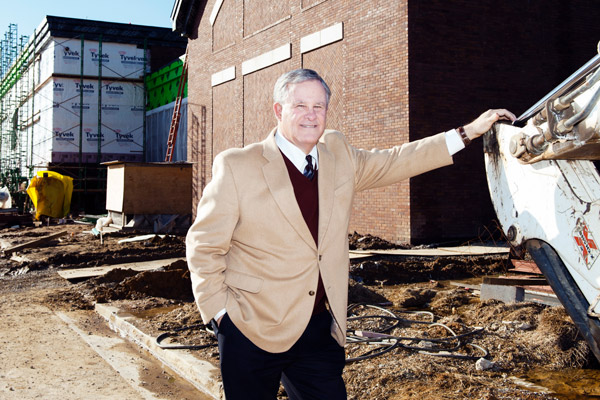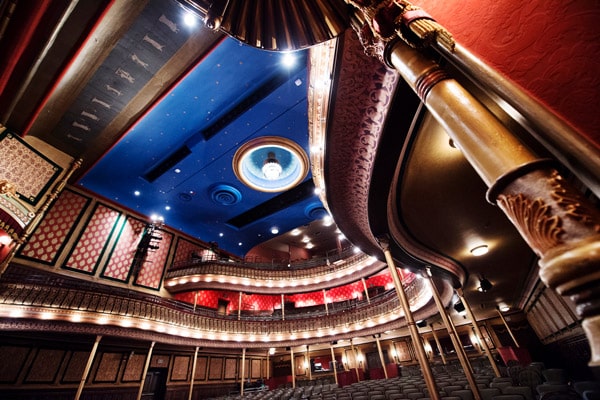
Many college students dream about returning to their alma mater a few decades in the future and contributing as a campus leader.
For Tim Muzzi, university architect, director of planning, design, and construction administration for Mississippi State University, it is a dream that he has fulfilled for nearly 14 years.
“When I came to Mississippi State for this position in 2004, the university architect had retired and the planning department consisted of one person,” says Muzzi. “Now we have a gem of a staff of about a dozen people and we are planning for more.”
Since his arrival in 2004, Muzzi has overseen nearly $1 billion in renovations and new additions to the campus, from classrooms, athletics, entertainment, education, and everything in between.
“I came from a private practice, so we had to immediately develop standards that we could adhere to,” says Muzzi. “Now we are all about good design and project management, making sure we meet all expectations and guidelines for budget, scope, and quality. We provide a critical path schedule to make sure we meet those guidelines, and we are pretty demanding to make sure all guidelines are met.”
An SEC Stadium Story
As a longtime member of the Southeastern Conference (SEC), arguably the country’s most popular and competitive collegiate athletic conference in both baseball and football, Muzzi finds himself in the middle of the competition. He has risen to the challenge with two athletic stadium renovations that totaled over $130 million.
“College alumni mainly care about two things—what their campus looks like now, and what new buildings are being erected and planned,” says Muzzi. “And in the SEC, a lot of attention is paid to athletics and facilities.”
The football stadium renovation, which began in 2012, cost $80 million and was completed in time for the 2014 season. The renovation enclosed the north end zone, creating a louder stadium experience while developing space for end zone-level suites. On the south end zone, “The Junction” area is now a large green space for students, alumni, and fans to tailgate and enjoy the experience. The renovations increased the stadium’s capacity to 67,500.
“It is the second-oldest stadium in the country, so there was a lot of infrastructure underground that we had no record of existing,” says Muzzi. “There were sewer lines, phone lines, and foundation issues, along with the time restraints of building the structure while the stadium was still occupied.”
That massive undertaking wasn’t Muzzi’s last at MSU, however. He’s currently working on a $55 million renovation to the university’s baseball stadium.
The MSU baseball program is famous for producing MLB all-stars, including Will Clark, Rafael Palmeiro, and Bobby Thigpen. Not surprisingly, the program is incredibly popular—it holds all top ten attendance records for the collegiate sport.
The design for the project was recently completed, and the renovation process has begun.
“We had to tear down the existing stadium and raise the foundation,” says Muzzi. “We are putting in new club boxes and seating; we’re also adding lofts and condominiums in left field that fans can lease for games during the season. I do not think any other school in the country is giving their fans this experience.”
The renovation has eliminated the left field lounge, a popular destination where fans have traditionally pulled in on RVs, lounge chairs, and other homemade ‘inventions’ to watch the game. Luckily, the excitement for the new condos and the ability to watch games with balcony views has outweighed any sadness about the departure of the left field lounge.
“The homemade structures will be gone, but now we will have a series of decks and outfield lounges where fans can barbecue and enjoy an incredible experience,” says Muzzi. “The team will be playing a limited home schedule for the 2018 season and will have a full home schedule for the 2019 season. We are going to build a very intimidating environment for visiting teams.”
A Project Worth Singing About
The first major renovation project of Muzzi’s career had perhaps the most historical significance. In 2004, Muzzi led the $26 million renovation of the campus’ Grand Opera House, which was originally built in 1891.
The Opera House, which has been designated a historical landmark by the state of Mississippi, had been had been closed for 50 years prior to the renovation, which led to a number of challenges during the project.

“We had over 50 contractors on the project, so it was a real team effort,” says Muzzi. “We became the contractor, overseeing everything from the foundation to dry wall and painting.”
The project took two years, moving the building from the 19th century to the 21st century in less than 30 months.
“The centerpiece light was gas-fired, so we had to make that electric,” says Muzzi. “The structure was wood-framed and had no drawings we could reference, but we did find an original playbill show program from opening night in 1891.”
Muzzi and his team encountered other surprises that were less exciting, including water leaks in the basement. There were also the more expected challenges of renovating a building that was never designed to have a mechanical or electrical system.
“There were single-pane glass windows, so you have to worry about condensation, mold and mildew behind the plaster and wood rotting out,” says Muzzi. “But what they had was hand-made craftsmanship, so we had to bring that same tried and true quality into the 21st century.”
Creating a Better Campus
Along with the high-profile athletic and entertainment renovation projects, Muzzi has been involved with directing a wide range of educational and logistical projects, including their newest endeavor, a 150,00-square-foot project that’s being built to meet LEED Silver standards. Ninety thousand square feet will be used for classrooms and 60,000 square feet will be for parking; almost 11,500 students will pass through the building on a daily basis.
“Our average energy cost is approximately $2.25 per square foot in the previous buildings, while the estimated cost for the new building will be between 75 cents and 80 cents,” says Muzzi. “Self-tinted windows and the use of ice pods as heat exchangers will both contribute to a cheaper utility rate.”
Muzzi has already successfully undertaken many high-profile projects at MSU, and there are even more on the horizon. Ever the grateful alumnus, he credits the college’s leadership with making his successes possible.
“I could not imagine getting all this done without the support of an understanding president and vice president,” says Muzzi. “People want their universities to grow, be successful and look modern. Our job is to acknowledge our past and build toward the future.”
Photos: Beth Newman Wynn/Mississippi State University, Megan Bean
CLA has enjoyed partnering with MSU to implement energy-efficient design as a whole-building approach on new buildings and renovations. It is this team approach from preliminary design to post-occupancy that allows the building’s envelope and systems efficiency to match the architectural ideals of each project.


